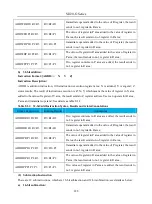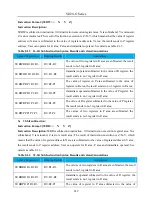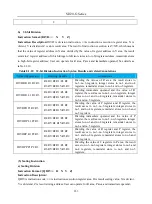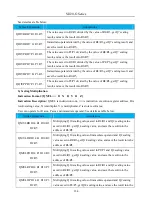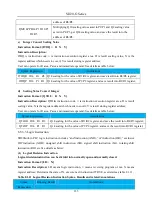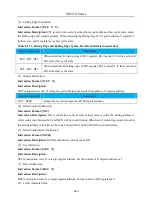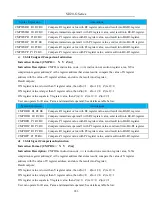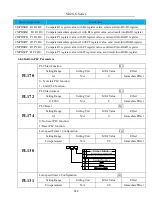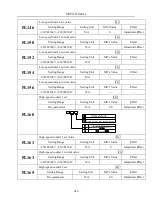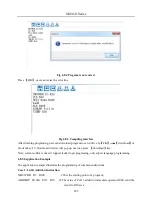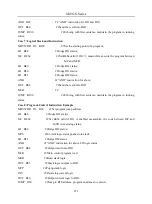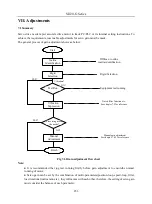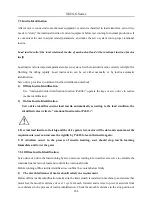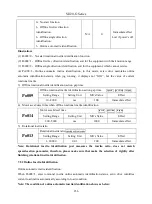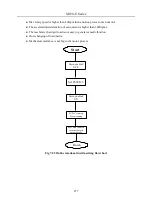
SD20-G Series
242
(11)
Idle Instruction
Instruction Format: [IDLE]
Instruction Description:
IDLE is instruction code, the program executes a dummy instruction
;
(12)
Comparison Instruction
The instruction is divided into 16-bit and 32-bit, can also be divided into signed number and unsigned
number based on data type, see details as tables below:
a)
16-bit Unsigned Comparison Instruction
Instruction Format: [CMPW□□ X Y Z(n)]
Instruction Description:
CMPW is instruction code, □□ is instruction execution register area, X,Yis
comparison register address; Z is the register address that stores results, compare the value of X register
address with the value of Y register address, and store the result into Z register;
Result output:
If X register value is lower than Y register value, then Z(n)=1
;
Z(n+1)=0
;
Z(n+2)=0
;
If X register value is higher than Y register value, then Z(n)=0
;
Z(n+1)=0
;
Z(n+2)=1
;
IF X register value equals to Y register value, then Z(n)=0
;
Z(n+1)=0
;
Z(n+2)=1
;
User can operate for R area, P area and immediate operand; See details as table below:
Syntax Expression
Annotations
CMPWRR R1 R2 B0
Compare R1 register value with R2 register value, send result into B0-B3 register.
CMPWDR D1 R2 B0
Compare immediate operand 1 with R2 register value, send result into B0-B3 register.
CMPWPR P1 R2 B0
Compare P1 register value with R2 register value, send result into B0-B3 register.
CMPWDP D1 P2 B0
Compare immediate operand 1 with P2 register value, send result into B0-B3 register.
CMPWRP R1 P2 B0
Compare R1 register value with P2 register value, send result into B0-B3 register.
CMPWPP P1 P2 B0
Compare P1 register value with P2 register value, send result into B0-B3 register.
b)
16-bit Signed Comparison Instruction
Instruction Format: [CMPWS□□ X Y Z(n)]
Instruction Description:
CMPWSis instruction code, □□ is instruction execution register area, X,Yis
comparison register address; Z is the register address that stores results, compare the value of X register
address with the value of Y register address, and store the result into Z register;
Result outputs:
If X register value is lower than Y register value, then Z(n)=1
;
Z(n+1)=0
;
Z(n+2)=0
;
If X register value is larger than Y register value, then Z(n)=0
;
Z(n+1)=0
;
Z(n+2)=1
;
If X register value equals to Y register value, then Z(n)=0
;
Z(n+1)=0
;
Z(n+2)=1
;
User can operate for R area, P area and immediate operand; See details as table below:
Summary of Contents for SD20-G Series
Page 35: ...SD20 G Series 35 M3 structure Fig 3 1 5 Servo drive structure 3...
Page 36: ...SD20 G Series 36 ML3 structure 118 5 5 7 5 93 297 8 223 118 93 0 5 12 5 7 5 4 M4...
Page 38: ...SD20 G Series 38 M4 structure Approx mass 10 365 kg Fig 3 1 7 Servo drive structure 5...
Page 39: ...SD20 G Series 39 M5 structure Approx msaa 11 1Kg Fig 3 1 8 Servo drive structure 6...
Page 40: ...SD20 G Series 40 M6 structure Approx mass 17 4Kg Fig 3 1 9 Servo drive structure 7...
Page 182: ...SD20 G Series 182 Fig 6 4 44SD20E Cam internal frameworkdiagram...

